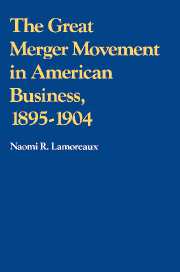Book contents
- Frontmatter
- Contents
- Acknowledgments
- List of tables and figures
- 1 Introduction
- 2 Product differentiation, mass production, and the urge to merge: competitive strategies and collusion in the late nineteenth century
- 3 High fixed costs and rapid expansion: a model of price warfare and two examples
- 4 Quantitative and qualitative evidence on the great merger movement
- 5 What changed? The impact of consolidations on competitive behavior
- 6 The great merger movement and antitrust policy
- 7 Conclusion
- Bibliographical essay
- Index
5 - What changed? The impact of consolidations on competitive behavior
Published online by Cambridge University Press: 01 April 2010
- Frontmatter
- Contents
- Acknowledgments
- List of tables and figures
- 1 Introduction
- 2 Product differentiation, mass production, and the urge to merge: competitive strategies and collusion in the late nineteenth century
- 3 High fixed costs and rapid expansion: a model of price warfare and two examples
- 4 Quantitative and qualitative evidence on the great merger movement
- 5 What changed? The impact of consolidations on competitive behavior
- 6 The great merger movement and antitrust policy
- 7 Conclusion
- Bibliographical essay
- Index
Summary
For steel and newsprint manufacturers, the depression that followed the Panic of 1907 had strikingly different effects from the downturn in 1893. In both industries the earlier crisis had stimulated price warfare so severe that repeated attempts to end the competition proved fruitless. Manufacturers had tried banding together in pools, gentlemen's agreements, and selling agencies, but all these devices failed to stem the decline in prices. Finally they turned to consolidation for relief. By contrast, after the Panic of 1907, manufacturers successfully prevented outbreaks of price competition from recurring, and with only a minimum of organization. In November of 1907, Judge Elbert H. Gary, chairman of the United States Steel Corporation, called the nation's steelmakers together to talk about the state of the market–the first of the famous Gary dinners. Over the course of the next year the manufacturers met every few months to continue their discussions. These meetings, although certainly qualifying as collusive behavior, were much less formal and coercive than the elaborate pools of the 1890s. Yet, unlike the earlier pools, the Gary dinners were remarkably successful in preventing price cutting. Until January 1908, for example, manufacturers held the price of common-grade tin plate steady at its predepression level of $3.90 per box. Then, in response to the decline in demand, U.S. Steel announced a reduction to $3.70 per box, and this price was maintained without apparent difficulty for the rest of the year. Similarly, despite the Panic, the price of wire nails held at $2.23 per keg until U.S. Steel reduced it to $2.13 in April 1908. Manufacturers were able to maintain this price for a full year, again with little or no apparent difficulty.
- Type
- Chapter
- Information
- The Great Merger Movement in American Business, 1895–1904 , pp. 118 - 158Publisher: Cambridge University PressPrint publication year: 1985



